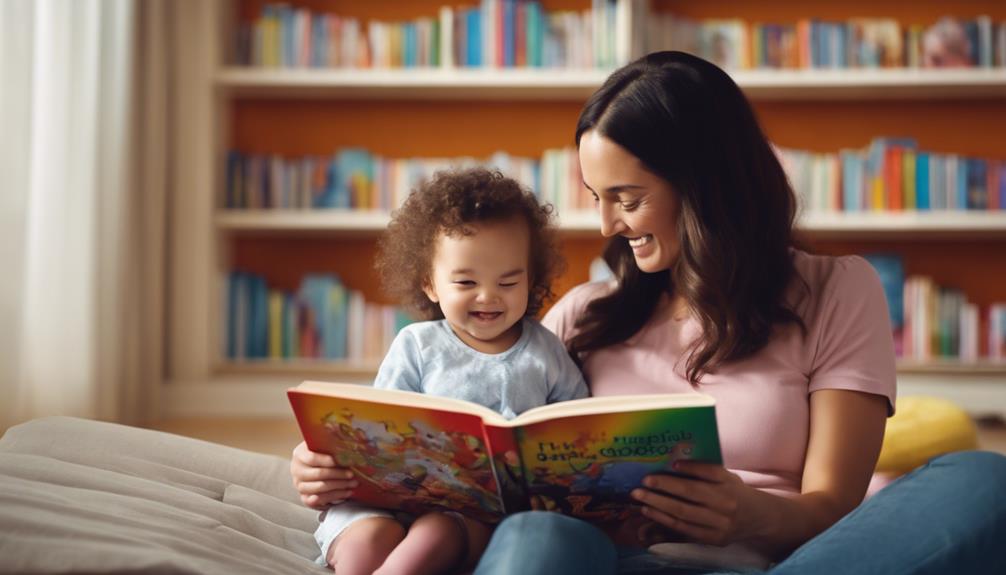Explore the insights of the ‘Your Baby Can Read’ program, utilizing CDs, books, and flashcards to enhance language development. The focus is on phonics, word retention, and visual cues through repeated practice. The Language Experience Approach speeds up infant development by highlighting visual cues and repetition. While effectiveness opinions differ, some studies indicate improved language abilities. Cost-effectiveness and parent-child interaction are debated points. Government scrutiny in 2012 resulted in marketing limitations. Overall, the program could improve cognitive abilities and language acquisition in children, with ongoing research. Parental involvement is crucial for educational advantages and child development progress. Delve deeper for a more comprehensive understanding.
Key Takeaways
- Mixed effectiveness opinions exist on the Your Baby Can Read program.
- Some studies suggest advanced language skills in children using the program.
- Concerns raised about lack of interactivity and parent-child interaction.
- Cost-effectiveness of the program is debated among users and researchers.
- Additional research needed to determine program efficacy accurately.
Program Overview
The Your Baby Can Read program immerses children in language development through a combination of CDs, books, and flashcards. This structured repetitive learning method aims to teach children to read by emphasizing phonics, word memorization, and visual clues. By utilizing holistic approaches like the Language Experience Approach (LEA), the program facilitates accelerated learning in infant development.
Through early exposure to language-rich materials, Your Baby Can Read fosters a thorough language experience that lays the foundation for future literacy skills.
The program's focus on visual cues and repetitive exposure to words creates a conducive environment for infants to absorb and internalize language patterns effectively. This approach not only enhances early language development but also sets the stage for advanced reading abilities later in life.
Effectiveness Analysis

Evaluating the effectiveness of the Your Baby Can Read program reveals a spectrum of viewpoints from users and researchers alike. Some parents reported mixed results with the program, while research findings varied. Some studies noted that children exposed to the program showed advanced language skills at an early age. However, concerns were raised regarding the lack of interactivity in the program, casting doubt on its overall effectiveness. Users emphasized the critical role of parent-child interaction in determining the program's success in helping children learn.
Opinions on the cost-effectiveness of the Your Baby Can Read program were also divided. Some individuals found the program to be overpriced compared to other available options. This discrepancy in views highlights the need for a more thorough understanding of the program's impact on children's language development.
Therefore, further research is necessary to explore the true efficacy of the program in enhancing early language skills in children.
Cost Considerations

Given the varying opinions on the cost of the Your Baby Can Read program, it's important to assess its value against alternative options available in the market. Some users view it as a worthwhile investment in their child's early education, while others consider it overpriced compared to similar products. Parents exploring do-it-yourself teaching methods often raise cost concerns when evaluating the program's cost.
The effectiveness of the program also plays a role in determining if the price is justified. Comparable products at lower prices prompt questions about the value of the Your Baby Can Read program. The price factor is a significant consideration for families deciding whether to enroll their children.
It's essential to weigh the benefits against the program's cost and consider how it aligns with your budget and educational goals.
Government Investigations Findings

Following the FTC lawsuit in 2012, 'Your Baby Can Read!' faced allegations of false claims and expert endorsements. The settlement resulted in the corporate defendant and company president agreeing, while Dr. Titzer faced trial proceedings. As a consequence, Dr. Titzer is now prohibited from incorporating 'Your Baby Can Read' in product names or logos.
Advertisers are warned against using misleading product names and endorsements without proper vetting. The focus of government investigations emphasized the necessity of ensuring that advertising claims are both truthful and substantiated. This measure is vital to protect consumers from deceptive practices in the market.
Impact on Child Development

Your Baby Can Read program has been linked to cognitive skills enhancement in some children, potentially boosting language acquisition and progressing reading readiness.
These impacts on child development are key factors to consider when evaluating the program's effectiveness and suitability for your child's learning journey.
Understanding how the program influences cognitive skills, language acquisition, and reading readiness can help you make informed decisions about incorporating it into your child's developmental activities.
Cognitive Skills Enhancement
Enhancing your child's cognitive skills through programs like Your Baby Can Read can positively impact their overall development, particularly in language proficiency. The program's focus on early literacy exposure and interactive reading experiences contributes to the enhancement of various cognitive abilities, shaping a solid foundation for your child's future learning journey.
Consider the following emotional cues:
- Excitement: Witness your child's enthusiasm as they discover new words and concepts.
- Empowerment: Experience the pride of seeing your little one develop essential literacy skills.
- Connection: Strengthen the bond with your child through engaging parent-child reading sessions.
- Confidence: Watch as your child gains confidence in their reading and learning abilities.
- Joy: Share moments of joy as you witness your child's cognitive growth and language development flourish.
Through the Your Baby Can Read program, you can actively participate in nurturing your child's cognitive skills and laying the groundwork for their educational success.
Language Acquisition Boost
Some children have demonstrated advanced language skills as a result of participating in the Your Baby Can Read program. Early language development is vital for children, and programs like Your Baby Can Read aim to enhance language acquisition through methods such as the language experience approach (LEA) and phonics.
Parents play a significant role in fostering language development through positive parent-child interaction, which can further support the child's progress in language acquisition.
Children incidentally exposed to the Your Baby Can Read materials may enjoy the songs and activities provided, which can contribute to their language learning experience. However, concerns have been raised about the program's use of screen time and the potential lack of interactivity it offers.
While some users report positive outcomes regarding language development, results are mixed overall, indicating that the effectiveness of the program for child development may vary from child to child. It's crucial to take these factors into account when evaluating the impact of language acquisition programs on young learners.
Reading Readiness Progress
The effectiveness of the Your Baby Can Read program in fostering reading readiness and language development varies among children, with some showing advanced skills while others may not find it as beneficial for early reading.
When evaluating reading readiness progress and language development, it's important to take into account the impact of parent-child interaction, the level of interactivity in the program, and how it compares to traditional teaching methods.
The Your Baby Can Read program has elicited mixed results in child development, with some children displaying advanced language skills post-program, while others may not experience the same benefits. It's essential to assess the program's impact on children's readiness for reading and language acquisition critically.
- Parents' emotional testimonials about their children's progress can be both heartwarming and concerning.
- The varying results reported by users can evoke a sense of uncertainty and curiosity.
- The importance of effective parent-child interaction may resonate deeply with readers.
- Concerns about the lack of interactivity in the program could elicit skepticism or caution.
- The discussion around traditional teaching methods versus innovative approaches may spark debate and reflection.
Importance of Parental Involvement

Active parental involvement is essential for supporting your child's learning and development, particularly in developing their literacy skills. Research consistently shows that children benefit greatly from parents who actively engage in educational activities. By participating in your child's learning journey, you can enhance their language skills, reading comprehension, and overall academic success.
Additionally, studies indicate that children with involved parents tend to exhibit better social skills, behavior, and emotional well-being. Collaborating with educators further reinforces the importance of parental involvement in promoting children's learning and school readiness.
As a parent, your role in fostering a supportive and enriching environment for your child's development can't be overstated. By being actively involved in your child's educational pursuits, you play a critical part in shaping their future success and well-being. Embrace this role with enthusiasm and dedication, knowing that your efforts are instrumental in nurturing your child's growth and achievements.
Frequently Asked Questions
Is My Baby Can Read Legit?
Yes, your baby can read! Trust your instincts and observe your child's progress. Keep encouraging and fostering a love for learning. Remember, every child is unique, so celebrate the milestones along the way.
What Happened to Your Baby Can Read?
Your Baby Can Read faced legal action for false claims and endorsements in 2012. The FTC lawsuit resulted in a settlement with the company and president. Dr. Titzer chose trial and was banned from using the program name in products.
What Is the Program That Teaches Babies to Read?
You can explore programs like "Your Baby Can Read" which aimed to teach infants to read using engaging methods. These programs focus on word memorization through songs and visuals, potentially enhancing language skills.
When to Start Your Baby Can Read Program?
Begin the Your Baby Can Read program when your child displays interest in books and words, typically around 3-5 months old. Keep in mind their readiness. Early exposure to language enhances literacy skills and nurtures a love for reading.
Conclusion
To sum up, the insights provided by the 'Your Baby Can Read' program offer a unique perspective on child development and early literacy skills.
With a focus on parental involvement and cost considerations, the program has shown promising results.
However, further investigation and analysis are needed to fully understand its effectiveness.
Stay tuned for future updates on this intriguing program and its impact on young minds.










